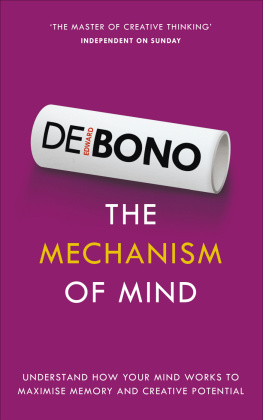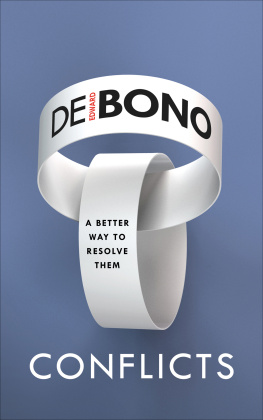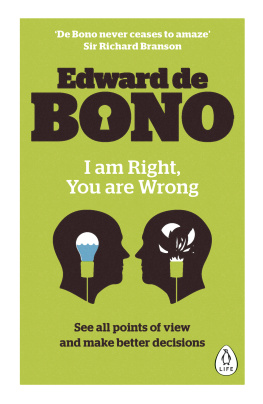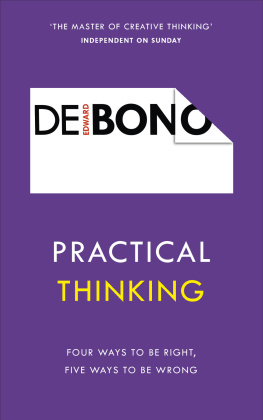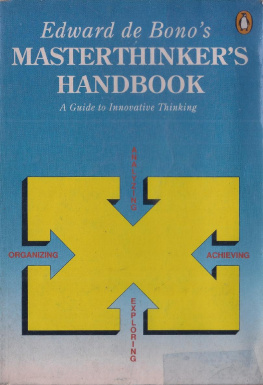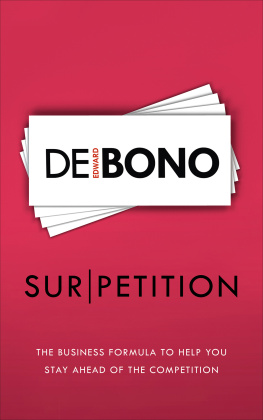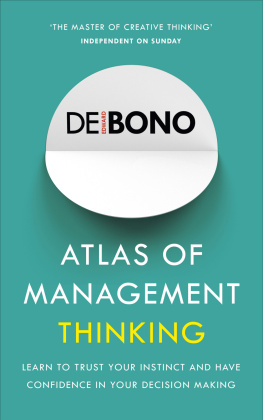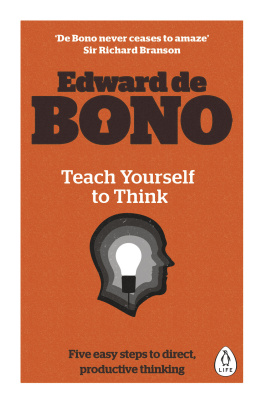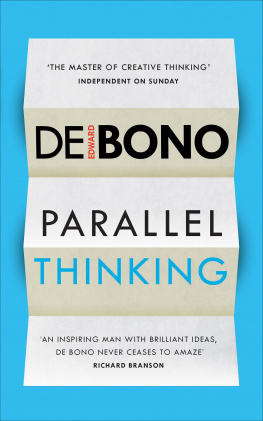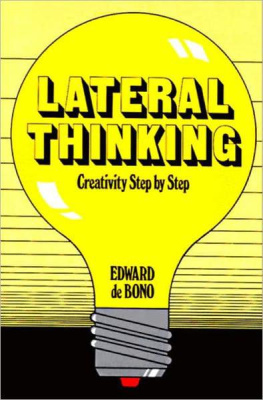Edward de Bono - Six Thinking Hats
Here you can read online Edward de Bono - Six Thinking Hats full text of the book (entire story) in english for free. Download pdf and epub, get meaning, cover and reviews about this ebook. year: 2017, publisher: Penguin Books Ltd, genre: Art. Description of the work, (preface) as well as reviews are available. Best literature library LitArk.com created for fans of good reading and offers a wide selection of genres:
Romance novel
Science fiction
Adventure
Detective
Science
History
Home and family
Prose
Art
Politics
Computer
Non-fiction
Religion
Business
Children
Humor
Choose a favorite category and find really read worthwhile books. Enjoy immersion in the world of imagination, feel the emotions of the characters or learn something new for yourself, make an fascinating discovery.
- Book:Six Thinking Hats
- Author:
- Publisher:Penguin Books Ltd
- Genre:
- Year:2017
- Rating:3 / 5
- Favourites:Add to favourites
- Your mark:
- 60
- 1
- 2
- 3
- 4
- 5
Six Thinking Hats: summary, description and annotation
We offer to read an annotation, description, summary or preface (depends on what the author of the book "Six Thinking Hats" wrote himself). If you haven't found the necessary information about the book — write in the comments, we will try to find it.
Six Thinking Hats — read online for free the complete book (whole text) full work
Below is the text of the book, divided by pages. System saving the place of the last page read, allows you to conveniently read the book "Six Thinking Hats" online for free, without having to search again every time where you left off. Put a bookmark, and you can go to the page where you finished reading at any time.
Font size:
Interval:
Bookmark:
| Six Thinking Hats: Run Better Meetings, Make Faster Decisions |
| Edward de Bono |
| Penguin Books Ltd (2017) |
THE classic work about decision-making from the world-renowned writer and philosopher Edward de Bono
Meetings are a crucial part of all our lives, but too often they go nowhere and waste valuable time. In Six Thinking Hats, Edward de Bono shows how meetings can be transformed to produce quick, decisive results every time.
The Six Hats method is a devastatingly simple technique based on the brain's different modes of thinking. The intelligence, experience and information of everyone is harnessed to reach the right conclusions quickly.
These principles fundamentally change the way you work and interact. They have been adopted by businesses and governments around the world to end conflict and confusion in favour of harmony and productivity.
Edward de Bono is a Maltese physician, author, inventor and consultant. He originated the term lateral thinking, wrote the book Six Thinking Hats and is a proponent of the teaching of thinking as a subject in schools.


Edward de Bono invented the concept of lateral thinking. A world-renowned writer and philosopher, he is the leading authority in the field of creative thinking and the direct teaching of thinking as a skill. In the decades since Dr de Bono introduced lateral thinking, the concept has become so entrenched in our language that it is used equally in physics lectures, television comedies or brainstorming sessions. His key contribution has been his understanding of the brain as self-organising system. His work spans generations, continents and belief systems, and is equally influential in the boardrooms of leading businesses such as Apple and British Airways as on the shelves of classrooms in rural Africa.
Dr de Bono has written more than sixty books, in forty languages, with people now teaching his methods worldwide. He has chaired a special summit of Nobel Prize laureates, had faculty appointments at the universities of Oxford, London, Cambridge and Harvard, and been hailed as one of the 250 people who have contributed most to mankind.
Dr de Bonos classic bestsellers include Six Thinking Hats, Lateral Thinking, I Am Right You Are Wrong, How To Be More Interesting, Teach Yourself To Think, Teach Your Child How To Think, and Simplicity.
www.debono.com
The Six Thinking Hats method may well be the most important change in human thinking for the past twenty-three hundred years.
That may seem a rather exaggerated claim but the evidence is beginning to point that way. When this book was first published fourteen years ago, such a claim would have been nonsense. But over the years, the evidence to support it has been steadily accumulating.
A major corporation (ABB) used to spend thirty days on their multinational project team discussions. Using the parallel thinking of the Six Hats method, the discussions now take as little as two days. A researcher from a top IBM laboratory told me that the Six Hats method had reduced meeting times to one quarter of what they had been. Statoil in Norway had a problem with an oil rig that was costing about one hundred thousand dollars a day. A certified trainer, Jens Arup, introduced the Six Hats method and in twelve minutes the problem was solved and the one-hundred-thousand-dollar-a-day expenditure was reduced to nil. There were two similar law cases: in one case the jury took more than three hours to reach a decision. In the second case, one juror introduced the Six Hats method. A decision was reached in fifteen minutes. In a simple experiment with three hundred senior civil servants, the introduction of the Six Hats method increased thinking productivity by 493 per cent.
Those examples show huge changes. We are normally very happy with productivity increases of 5 or 10 per cent. Here we have changes of 500 per cent and more. Something is happening.
I can report that the Six Hats method is now very widely used around the world. When I first designed the concept I had no idea how rapid the spread would be. The method is simple, robust and effective which accounts for the very widespread use.
Last year I received two letters on the same day. One letter was from the head of research at Siemens in Germany. Siemens is by far the largest corporation in Europe with close to four hundred thousand employees and a turnover in excess of sixty billion dollars. They now have thirty-seven internal trainers in my methods and every department has a special innovation unit based on my methods. In his letter, the head of research told how he had used the Six Hats method with success at a senior research meeting. The second letter was from Simon Batchelor, who had been on an aid mission to Cambodia to help the Khmer villagers drill for water. He found it difficult to get the villagers involved in the process. He had my book Teach Your Child How To Think with him and, from this book, he taught the Six Hats method to the Khmer villagers. They became so enthusiastic that they told him that learning to think was more important than drilling for water.
A few days later I was in Wellington, New Zealand, and the head teacher of Wellesley School (a leading school in New Zealand) told me that he was teaching the method to five-year-olds. (A few months later, the head teacher of Clayfield College in Brisbane told me that they even taught it to four-year-olds.) A week after being in New Zealand I spoke at a major Microsoft marketing meeting in Seattle and introduced the attendees to the parallel thinking of the Six Hats method. The method has been used by NASA, IBM, DuPont, NTT (Japan), Shell, BP, Statoil (Norway), Marzotto (Italy), and Federal Express, among many others. This shows the remarkable adaptability of the Six Hats method: it can be taught with equal success to top-level executives and to pre-school children.
Thinking is the ultimate human resource. Yet we can never be satisfied with our most important skill. No matter how good we become, we should always want to be better. Usually, the only people who are very satisfied with their thinking skill are those poor thinkers who believe that the purpose of thinking is to prove yourself right to your own satisfaction. If we have only a limited view of what thinking can do, we may be smug about our excellence in this area, but not otherwise.
The main difficulty of thinking is confusion. We try to do too much at once. Emotions, information, logic, hope and creativity all crowd in on us. It is like juggling with too many balls.
What I am putting forward in this book is a very simple concept which allows a thinker to do one thing at a time. He or she becomes able to separate emotion from logic, creativity from information, and so on. The concept is that of the six thinking hats. Putting on any one of these hats defines a certain type of thinking. In the book I describe the nature and contribution of each type of thinking.
Font size:
Interval:
Bookmark:
Similar books «Six Thinking Hats»
Look at similar books to Six Thinking Hats. We have selected literature similar in name and meaning in the hope of providing readers with more options to find new, interesting, not yet read works.
Discussion, reviews of the book Six Thinking Hats and just readers' own opinions. Leave your comments, write what you think about the work, its meaning or the main characters. Specify what exactly you liked and what you didn't like, and why you think so.


